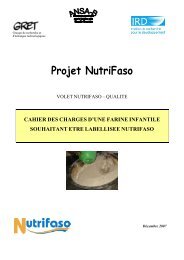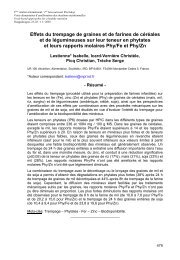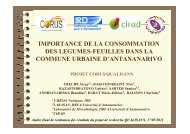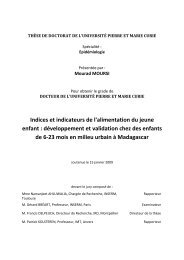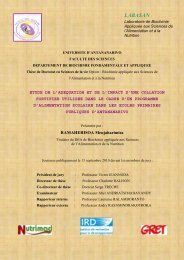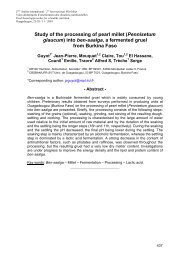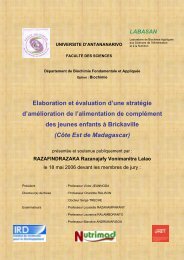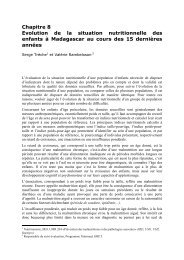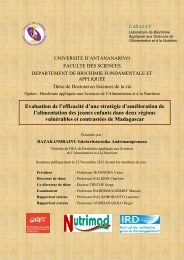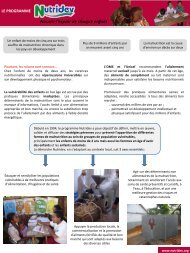THESE UNIQUE El Hassane Kéhien-Piho TOU - Nutridev
THESE UNIQUE El Hassane Kéhien-Piho TOU - Nutridev
THESE UNIQUE El Hassane Kéhien-Piho TOU - Nutridev
Create successful ePaper yourself
Turn your PDF publications into a flip-book with our unique Google optimized e-Paper software.
Annexe-6<br />
18 th International Congress of Nutrition, 19 - 23 September 2005, ICC, Durban, South Africa.<br />
POSTER PATHWAY 8: Indigenous foods, novel foods, functional foods and safe foods<br />
Nutritional and microbial characteristics of ben-saalga, a millet-based fermented gruel<br />
from Burkina Faso used as complementary food<br />
E. H. Tou 1, 2* , C. Mouquet-Rivier 2 , A. S. Traoré 1 , S. Trèche 2 , JP. Guyot 2<br />
1 Université de Ouagadougou/UFR-SVT/ CRSBAN, Burkina Faso<br />
2 UR106 « Nutrition, Alimentation, Sociétés », Institut de Recherche pour le Développement<br />
(IRD), BP 64501, 34394 Montpellier, France<br />
*corresponding author: elassane@yahoo.fr<br />
Abstract<br />
Ben-saalga is a millet-based fermented gruel frequently used as complementary food in<br />
Burkina Faso. The objective of this study is to describe the traditional processing methods,<br />
nutritional and microbial compositions which are necessary for investigating ways to improve<br />
both the nutritional and sanitary quality of the foodstuff. In this work, the traditional<br />
processing of pearl millet into ben-saalga and fermentation kinetics were investigated in 24<br />
and 5 traditional production units, respectively. Processing steps include: washing (optional),<br />
soaking of the grains (first fermentation step), grinding and sieving of the wet flour, settling<br />
(second fermentation step), and cooking. The soaking step was mainly characterized by<br />
alcoholic fermentation whereas lactic acid fermentation occurred during the settling step. The<br />
paste produced at the end of settling had a low pH value (4.0 ± 0.4) and its micro biota was<br />
dominated by lactic acid bacteria (LAB) with an Amylolytic LAB: LAB ratio of 12%.<br />
Sucrose disappeared in the grains during soaking but was not detected in the soaking water,<br />
whereas glucose, fructose and maltose appeared transiently. Glucose and fructose were the<br />
main substrates observed for lactic acid fermentation during the settling step. At the end of the<br />
processing, 75% and 83% decrease was observed in phytate (IP6) and raffinose, respectively.<br />
The sour gruel ben-saalga resulting from cooking the sour paste had inadequate nutritional<br />
characteristics with respect to infants’ and young children’s requirements; it was characterized<br />
by fluid consistency (Bostwick flow: 137 mm/30s), low protein (8.2 ± 0.9 g/100g DM) and fat<br />
content (4.7 ± 0.8 g/100g DM) and low energy density (about 30 kcal/100g of gruel).<br />
Therefore, further investigations are needed to improve the nutritional quality of ben-saalga<br />
to cover nutritional needs of young children and infant of Burkina Faso.<br />
Key-words: lactic acid fermentation, pearl millet, complementary food, phytate, α-<br />
galactoside, amylolytic lactic acid bacteria



